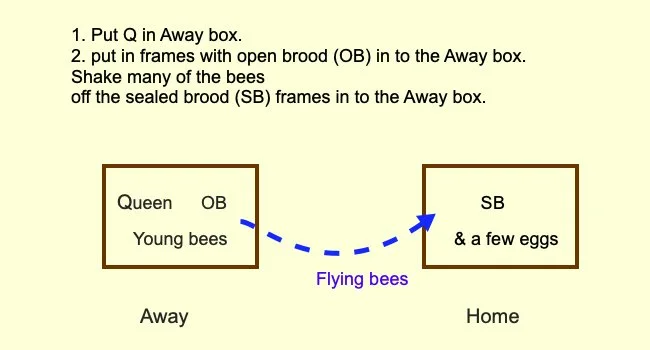Dolittle reverse split
This is useful for swarm prevention rather than control
In the spring, the bees want to send the old queen away with some of the bees to start a new colony. This is what a Reverse Split emulates.
Get an empty single-box hive & floor. This goes to a new location. Find the queen and put her on her frame into the new hive. Transfer a couple of combs of stores, then one of pollen, and the bees on them to the new hive. (The new colony needs plenty of pollen and stores since it will have no foragers for a few days). Now, go through the frames one by one. Predominantly open brood goes to the new hive, along with the bees on those frames (which will be mainly many nurse bees). Just set them in place in the order they came out. Any frames that contain capped brood get shaken out over the new colony (including the queen if you have not found her at the start) and then placed in the parent hive. You do not need to shake every single bee off. When you finish, the open brood, the queen, and almost all bees will be in the new hive. The capped brood will be in the parent hive, with a few bees left after some shakes.
You need to leave some eggs in the parent hive so that it can make a new queen, but it would be practically impossible not to do so. Many of the frames will have a mixture of open and capped brood; we are just choosing where they go based on what the majority of the brood is.
Analysis: The foragers will return to the parent hive. The capped brood will begin emerging, and the parent hive will return to a nice balance of nurses and foragers. The new hive will contain enough nurses to support the queen, and they will begin maturing into foragers so that this hive also returns to a balance of nurses and foragers. The queen ends up with about 30% of the total bees that were in the hive, vs. only 15% that would remain with her in a 50/50 split. She can begin building the hive numbers rapidly with plenty of nurses to cover the brood.
One week after the split, inspect both colonies. The new colony should have the queen and eggs. The parent colony should have capped queen cells. Since they are emergency cells, you do not need to reduce to one QC. Close up and leave them alone for enough days for the queen to get laying. In fine weather, she takes two days maturing, three days making orientation flight, and 1-3 days mating. So 16 days + 8 = 24 days from d1 egg to laying. If the weather is poor for 21 days after she emerges, she will become a drone layer.
If there are open swarm cells already, remove all queen cells in the new hive. But If you miss killing a QC in the new colony, do not worry because when the foragers return to the mother colony, the bees will destroy the QCs.
If there are closed QC, the existing queen has probably already left with a swarm, but maybe you can’t tell because there are so many bees. Have a good look for her. If you can not find her, look for the youngest brood - this will give you a clue as to how long ago she left. If she has left and there are no larvae two days old, and you destroy all the QC, then they will not be able to make a new good quality queen without your assistance. So, if you still want to do a split, leave one QC in each part.
If the new colony contains the queen, they will not swarm and will break down the QC. If she is in the parent colony, she will still want to swarm. If there are d5 larvae (larva two days old), you could destroy all the QC in this part and put a QE above the floor. This will give you some time to have another look to see if she is still there. If she is not there, remove the QE so a new virgin can mate. You may not want to bother with this and accept that she has left.
If some have emerged and there are closed QC in the mother hive, you can not do a split. Let the queens out of the closed cells using a scalpel. In the subsequent confusion, no further casts will issue.
If it goes wrong, the beauty of this split is that even if she still goes with a swarm, she only takes a quarter of your bees instead of half with a 50:50 split.
If you want to do a vertical split, the top entrance must point away from the bottom hive entrance. Leave the mesh open between the colonies so the hives can form a two-queen hive.
Source - an article in the Colorado Beekeepers Association
